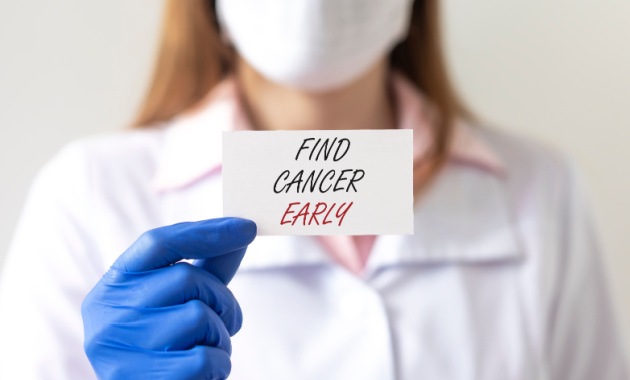
Cancer can often remain hidden within the body showing only subtle signs and symptoms without noticeable indications. Detecting cancer early is important for more effective treatment, fewer side effects, and improved long-term survival rates. Advancements in understanding the symptoms, defining cancer stages, and implementing optimal testing methods are key to progress. Cost-effective and widely accessible detection and prevention approaches are necessary to mitigate the financial, physical and psychological burden of cancer[1].
Early detection saves lives.
Schedule your cancer screening now!
Early detection can be achieved through two methods: screening and early diagnosis[1].
1. Screening tests: These aim to identify individuals who have the disease but do not yet display symptoms. Examples include mammography for breast cancer and Pap smears for cervical cancer.
Various screening methods include:
A. Physical examination: Healthcare providers visually examine the body, checking for abnormalities or new growths and gathering information about the patient’s health status and medical history. This essential step helps identify potential risk factors, guide further diagnostic procedures, and contribute to a more accurate diagnosis and treatment plan.
Consult a doctor for early cancer detection with a tailored physical examination.
B. Laboratory tests: Laboratory tests, such as blood or urine tests, help evaluate specific markers, hormones, or cancer-associated biomarkers. By leveraging advanced laboratory techniques and technologies, doctors can obtain vital diagnostic information that aids in early detection, accurate diagnosis, and appropriate treatment planning.
C. Diagnostic procedures: Diagnostic procedures like mammography aid in the early detection of breast cancer, using X-rays to capture detailed images for timely intervention. Pap smear helps in cervical cancer screening, identifying abnormalities or HPV presence, and enabling early detection and prevention. PSA test screens for prostate cancer by measuring prostate-specific antigen levels, guiding further evaluation and management.
D. Imaging procedures: Imaging procedures such as ultrasound, X-ray, CT scan, or MRI provide detailed images of internal body areas, aiding in diagnosing various conditions, including cancer, by visualizing abnormalities and guiding further evaluation and treatment planning. PET-CT scans use safe radioactive tracers to visualize organ activity, helping detect cancer and diagnose brain and heart disorders. PET scans offer prompt and accurate diagnostic information by revealing cellular-level metabolic changes.
Book a PET scan and leverage advanced imaging technology to detect diseases at an early stage.
E. Genetic tests: These are important in identifying gene mutations that may be linked to certain types of cancer. By detecting these mutations, an individual’s predisposition to cancer can be assessed, and personalized screening and prevention strategies can be developed.
Don’t wait for symptoms to appear. Take this Genetic test!
2. Early Diagnosis: Early diagnosis refers to detecting cancer at its earliest stage by
raising patient awareness about common cancer symptoms and training healthcare
professionals to recognize and refer individuals with potential early signs. Although not
as comprehensive as screening, it is crucial in detecting prevalent cancers like
breast, skin, and stomach. Biopsies, a procedure involving the removal of a small piece of tissue or cells, serve as a valuable tool not only for diagnosing cancer but also for identifying various other diseases. Biopsies can be performed through various methods such as needles, endoscopy, or surgery, providing valuable insights for effective healthcare decisions. Early diagnosis is an essential element of any effective early
detection program, considering that not all individuals participate in or have access to
screening, and certain cancers may go undetected through screening alone.
Raising awareness and promoting screening tests can help minimize cancer incidence, mitigate its impact on health, prevent disabilities, and reduce mortality rates associated with the disease. Trust your instincts when it comes to your body. If you experience anything unusual or unsettling, don’t hesitate to consult your doctor. While most cases won’t be cancer, detecting it early can have a significant impact on your health and well-being.
(The article is written by Dr.Subita Alagh, Senior Executive, and reviewed by Monalisa Deka, Senior Health Content Editor)
References
1. World Health Organization: Cancer – Screening and early detection
https://www.who.int/europe/news-room/fact-sheets/item/cancer-screening-and-early-detection-of-cancer